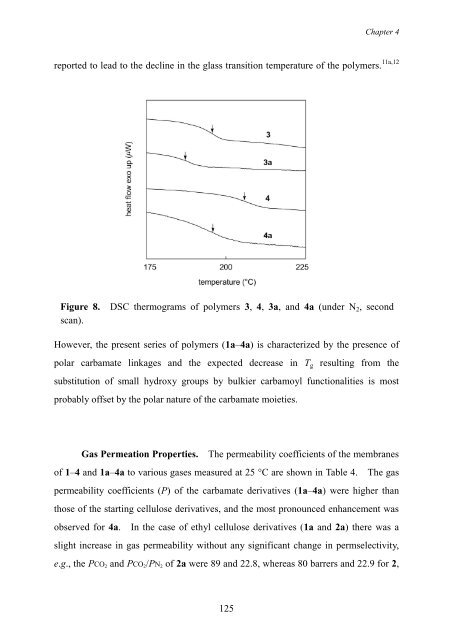Synthesis, Characterization, and Gas Permeation Properties
Synthesis, Characterization, and Gas Permeation Properties
Synthesis, Characterization, and Gas Permeation Properties
Create successful ePaper yourself
Turn your PDF publications into a flip-book with our unique Google optimized e-Paper software.
125<br />
Chapter 4<br />
reported to lead to the decline in the glass transition temperature of the polymers. 11a,12<br />
Figure 8. DSC thermograms of polymers 3, 4, 3a, <strong>and</strong> 4a (under N2, second<br />
scan).<br />
However, the present series of polymers (1a–4a) is characterized by the presence of<br />
polar carbamate linkages <strong>and</strong> the expected decrease in Tg resulting from the<br />
substitution of small hydroxy groups by bulkier carbamoyl functionalities is most<br />
probably offset by the polar nature of the carbamate moieties.<br />
<strong>Gas</strong> <strong>Permeation</strong> <strong>Properties</strong>. The permeability coefficients of the membranes<br />
of 1–4 <strong>and</strong> 1a–4a to various gases measured at 25 °C are shown in Table 4. The gas<br />
permeability coefficients (P) of the carbamate derivatives (1a–4a) were higher than<br />
those of the starting cellulose derivatives, <strong>and</strong> the most pronounced enhancement was<br />
observed for 4a. In the case of ethyl cellulose derivatives (1a <strong>and</strong> 2a) there was a<br />
slight increase in gas permeability without any significant change in permselectivity,<br />
e.g., the PCO2 <strong>and</strong> PCO2/PN2 of 2a were 89 <strong>and</strong> 22.8, whereas 80 barrers <strong>and</strong> 22.9 for 2,

















